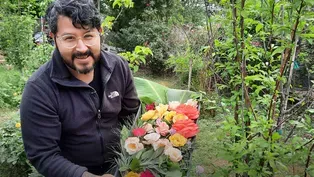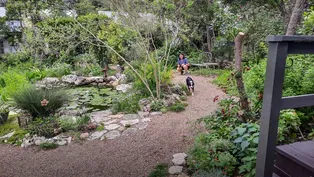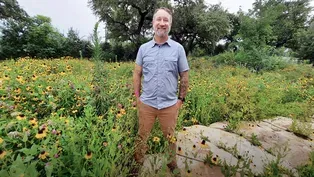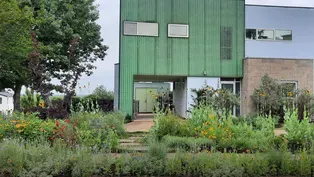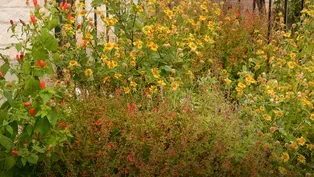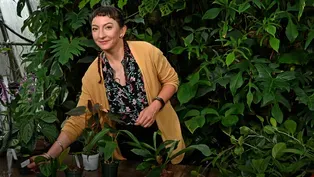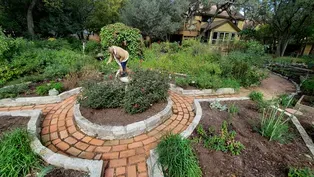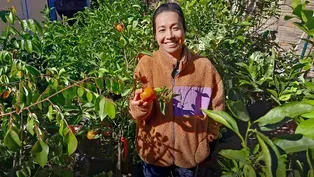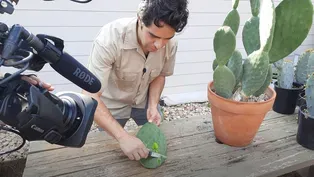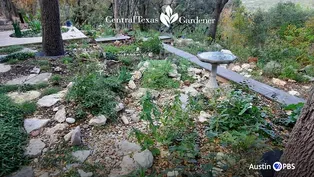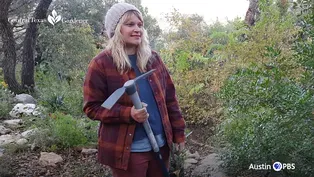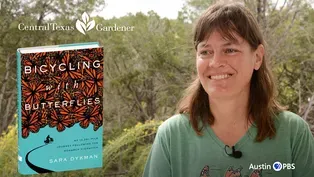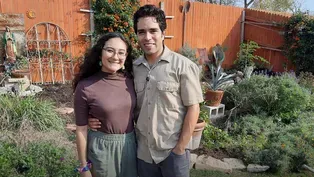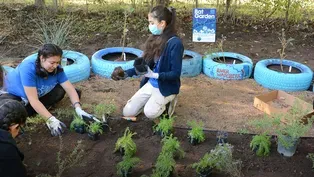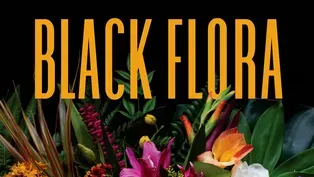
Remaking a Yard into Flowers, Food, Joy
Clip: Season 27 | 8m 34sVideo has Closed Captions
Permaculture restored lifeless soil and wildlife habitat for gardens and outdoor living.
Kristin and Ryan Harvey’s backyard was overrun with bamboo and the soil was lifeless. They asked, “What do we want in our dream garden?” Through permaculture, they restored the bond between soil, plants, and wildlife. Now, every morning is filled with flowers, fragrance, food they harvest, and teas from fruit and leaves. Always, they start and end the work day with discoveries and solace.
Problems with Closed Captions? Closed Captioning Feedback
Problems with Closed Captions? Closed Captioning Feedback
Central Texas Gardener is a local public television program presented by Austin PBS
Support for CTG is provided by: Lisa & Desi Rhoden, and Diane Land & Steve Adler. Central Texas Gardener is produced by Austin PBS, KLRU-TV and distributed by NETA.

Remaking a Yard into Flowers, Food, Joy
Clip: Season 27 | 8m 34sVideo has Closed Captions
Kristin and Ryan Harvey’s backyard was overrun with bamboo and the soil was lifeless. They asked, “What do we want in our dream garden?” Through permaculture, they restored the bond between soil, plants, and wildlife. Now, every morning is filled with flowers, fragrance, food they harvest, and teas from fruit and leaves. Always, they start and end the work day with discoveries and solace.
Problems with Closed Captions? Closed Captioning Feedback
How to Watch Central Texas Gardener
Central Texas Gardener is available to stream on pbs.org and the free PBS App, available on iPhone, Apple TV, Android TV, Android smartphones, Amazon Fire TV, Amazon Fire Tablet, Roku, Samsung Smart TV, and Vizio.
Providing Support for PBS.org
Learn Moreabout PBS online sponsorshipWe started kind of dreaming about what is possible, like what do we want back here?
We kind of became students of the yard and the garden.
we have over 100 trees in the ground and in pots.
Over 70 of those are edible.
They make fruit or leaves or tea of some kind.
music Hi, I am KristIn Harvey.
And this is our garden.
Yeah.
And I'm Ryan Harvey, and we we bought this house in 2014, and when we first moved in, there was a lot of bamboo and some trash trees.
We just spent years slowly taking out dead trees, dead plants, dead everything, and enriching the soil and planting things in the ground just to see what would happen.
Yeah, we both cook a lot.
And so I think that was probably one of the first kind of impetuses for us was just, well, we want to grow our own, our own herbs, maybe some of our own food.
And so a friend of ours as a housewarming gift gave us a book about permaculture.
Instead of sending leaves off to the city, we started mulching them and building soil, doing lasagna gardening in beds and learning more about cover cropping.
So we would cover crop areas after we pulled out the vegetation and just kind of started seeing the transformation of the soil mulching like crazy.
So they just kind of started spiraling after that into all these fun, different projects.
We actually got Patricia Michael to come out and just kind of walk through with us to help us like, what could we do?
We just hadn't really thought about all all of our needs or that we could get them.
So things like screen from the road, place to cook and eat, shade, edibles, a lot of plants in one space, all these sorts of things.
And then she helped us chunk up the work and that's what we had.
A lot of family members and friends come and help us.
I don't know how many hours my brother was out here removing bamboo and just helping us to sort of move along that path to get to our goals of having different sort of like rooms out here for different purposes.
We like being out here, we like having coffee, like relaxing, we love animals.
And so over time, the visions kind of became, let's see how many edible things we can fit out here.
And then also how can we make this beautiful, how to make this relaxing a place that we can share with the people we love and and enjoy with their dog?
We relied a lot of, you know, discount plants and buying things on stages.
Seeds have been huge.
Yeah, seed saving and starting things from seed.
One of the wonderful things about having plants that make seeds is that you then have free plants.
The next year we had zinnias that we grew from seed one year and then, you know, at the end of the season chopped them off and I thought, Oh, I'll just throw them back in the bed.
And then the next year we had more zinnias.
We have wild rocket arugula that has just reseeded itself and just spread throughout one entire bed from one little plant.
We have a fennel that's on its third year that just spreads everywhere throughout the garden and it's delicious.
We eat the seeds, we eat the bulbs.
Yeah, perennials are a great money saver.
We also buy a lot of small plants.
Yes, Most everything came in a four inch pot.
It's going to get huge pretty quickly.
We have a Monterrey oak on the side that we planted that was small enough to fit in my SUV when we bought it and now we can see it from our second story window.
We probably have 15 plus moringa trees in the property, which are an excellent superfood.
I highly recommend everyone researches moringa and that I just I bought a $20 package of organic seeds, sprouted them myself and we just started planting them around everywhere.
We've gone through a couple of stretches where we didn't have to buy vegetables from the store, but our our big goal is just growing our own greens and herbs.
And so we like to be able to have a salad year round.
We knew we wanted to sit on the porch and just enjoy it.
And so we thought, you know , what, what can we do to make it even more enjoyable?
Big parts of that were screening.
We have a busy road not too far off over that way.
So we wanted screening, but we also wanted fragrance.
So we put almond verbena and mountain laurel right off the porch and we have a sweet olive over there and have planted another one here so that when you know the flowers are blooming, we get the fragrance and we can just sit here and see the butterflies.
During the pandemic, we met one of our neighbors because he would walk every day and he said he would walk past our almond verbena just to enjoy the smell.
And that was like his reward for going on a walk was getting to smell our tree.
Your mom gave us that one passion vine cutting.
It started way over by the shed about 30 feet away.
There are blooms under here and you can just the whole porch is filled with the fragrance, with the fragrance and things.
We started seeing more pollinators.
We wanted to have year round flowers.
That was kind of one thing we did was sort of sketch out okay, when when the things bloom.
I would start with more than one plant.
I would start in one tiny area.
Plants like to be together.
It's all part of one system that goes into the soil.
When everything dies back in the winter, we just try and leave it all until spring because it makes so much habitat.
Part of that is just thinking about all of the different things that live here and what they need to survive the winter, which is just dead stuff being it's fine.
You just chop and drop the vegetation that you draw.
It becomes mulch.
The insects, they they like to hide in there and we have hundreds of lizards.
We have anoles and spiny lizards.
We have a family of toads that lives over here under the corner of the porch.
We have skinks and we have snakes that will occasionally move in if we have a rodent problem.
We we have a four foot long rat snake that will make an appearance.
Cover cropping has been a big part of helping us build soil health and it's also can be very beautiful.
We've done buckwheat, we've done clover.
But I think one of our best tricks lately, we buy grain from Barton Springs Mill and we so we'll get these whole wheat berries.
They're all organically grown, so they'll sprout.
So we plant the wheat from the fall through the winter.
Kind of the new rhythm is when the first frost comes through and kills the remainder of the peppers and the eggplants and the basil that normally that bed gets.
The wheat.
That black-eyed peas, too, are great for for cover cropping, I would say.
I think, you know, the garden has become our happy place, not only just connects you to this place, but it also kind of connects us to, I think, our family histories as well.
My aunt is actually a professional horticulturalist and she loves to tell stories about how growing up they would drag me to these gardens and I would be like, Oh my God, not another plant.
And I was so annoyed growing up having to just go to Longwood Gardens and Hershey Gardens all the time.
And now I'm like, Oh, can we go to Longwood?
Because both of my grandmothers grew things.
My great grandparents on one side were farmers and on the other side my great grandmother was basically a poor Italian immigrant who grew food just to survive in their yard when they moved here.
Even our plants like that fig tree is like cutting from my dad's fig tree that we gave him for his 50th birthday.
I have a pomegranate tree that my friends bought me after my grandmother passed away because they know I don't like flowers that die like that.
So they gave me a pomegranate tree.
We changed a lot.
The more we got into gardening.
This kind of seeing how resilient nature and life can be.
The other day we were out with friends just talking about all the birds we've seen lately.
And I'll tell you what, like after a conversation like that, we're all so relaxed and so happy and so connected, so much more so than we talking about the stock market or all these other things.
This is real and these are things I want to talk about.
I want to share food with people.
We want to share our garden with people.
It's a connection.
Like it just kind of always draws us back.
It draws us back to the earth.
It's those patterns every day.
Earth Connections, Healing Gardens: Shaman Jesus Garcia
Video has Closed Captions
Clip: S27 | 8m 26s | Gardens heal the spirit, nourish the body, and cultivate play and wonder outdoors. (8m 26s)
Garden Diary of Life’s Progression: Colleen Belk
Video has Closed Captions
Clip: S27 | 8m 58s | Passion for plants led to a new career and an evolving garden. (8m 58s)
Transition to Urban Native Plant Pocket Prairie
Video has Closed Captions
Clip: S27 | 9m 18s | Discover the process to establish a native plant progression for wildlife habitat. (9m 18s)
Video has Closed Captions
Clip: S27 | 8m 54s | Lawn dominated their new yard when a couple unpacked their imagination on moving day. (8m 54s)
Native Plant Garden from Scratch in HOA: Kathleen Scott
Video has Closed Captions
Clip: S27 | 8m 33s | Deer and HOA rules didn’t stop Kathleen and Denny Scott’s wildlife habitat vision. (8m 33s)
Stunning Houseplants for Foliage and Flowers
Video has Closed Captions
Clip: S27 | 6m 6s | Quick tips to dazzle indoors and bright light patios in summer with orchid companions. (6m 6s)
Backyard Adventure with Vignettes: Jo Ann Glanz
Video has Closed Captions
Clip: S27 | 8m 59s | Surprises and experiences: That’s what Jo Ann Glanz wanted in her standard backyard. (8m 59s)
Remaking a Yard into Flowers, Food, Joy
Video has Closed Captions
Clip: S27 | 8m 34s | Permaculture restored lifeless soil and wildlife habitat for gardens and outdoor living. (8m 34s)
Suburban Backyard Food Forest: Phố Phạm
Video has Closed Captions
Clip: S27 | 9m 17s | Phố Phạm scrapped lawn to grow plant-based food for her family’s good health. (9m 17s)
Harvest Prickly Pear Pads for Nopalitos
Video has Closed Captions
Clip: S27 | 53s | Carlos Monteros shows how to pull off a prickly pear cactus pad (nopal) for recipes. (53s)
Dry Creek Hillside Design: Clay Soil and Shade
Video has Closed Captions
Clip: S27 | 9m 14s | Design to control rainwater runoff and erosion, planted with shade-lovers in clay soil. (9m 14s)
Video has Closed Captions
Clip: S27 | 2m 41s | Discover the trick to amending dense clay soil with landscape designer Leah Churner. (2m 41s)
Great Tool for Digging Rocky Clay Soil!
Video has Closed Captions
Clip: S27 | 1m 5s | Grab a pick to dig into clay soil that’s rocky, too, to get the job done. (1m 5s)
Bicycling With Butterflies: 10,201 Miles with Monarchs
Video has Closed Captions
Clip: S27 | 8m 40s | To chronicle habitat loss, Sara Dykman followed monarch migration across three countries. (8m 40s)
Blank Backyard to Southwest Cottage Habitat
Video has Closed Captions
Clip: S27 | 9m 17s | New gardeners honor cultural history and plants that support wildlife. (9m 17s)
Planting a Bat Friendly Garden with Native Plants
Video has Closed Captions
Clip: S27 | 7m 46s | Bring on beneficial bats with native plants that attract nighttime insects. (7m 46s)
Black Flora: Celebrating Black Flower Farmers and Florists
Video has Closed Captions
Clip: S27 | 15m 11s | Black Flora: Celebrating Black Flower Farmers and Florists (15m 11s)
How To Grow Microgreens: Easy Fresh Food Indoors
Video has Closed Captions
Clip: S27 | 4m 34s | Grow yummy, nutrition-packed microgreens indoors all year long. (4m 34s)
Providing Support for PBS.org
Learn Moreabout PBS online sponsorshipSupport for PBS provided by:
Central Texas Gardener is a local public television program presented by Austin PBS
Support for CTG is provided by: Lisa & Desi Rhoden, and Diane Land & Steve Adler. Central Texas Gardener is produced by Austin PBS, KLRU-TV and distributed by NETA.
